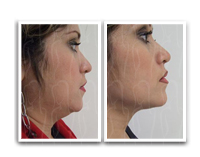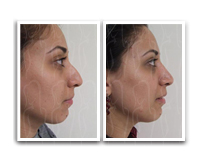Rhinoplasty

What is an Rhinoplasty
Rhinoplasty, or surgery to reshape the nose, is one of the most common of all plastic surgery procedures. Rhinoplasty can reduce or increase the size of your nose, change the shape of the tip or the bridge, narrow the span of the nostrils, or change the angle between your nose and your upper lip. It may also correct a birth defect or injury, or help relieve some breathing problems.
The best candidates for rhinoplasty
The best candidates for rhinoplasty are people who are looking for improvement, not perfection, in the way they look. If you're physically healthy, psychologically stable, and realistic in your expectations, you may be a good candidate. Rhinoplasty can be performed to meet aesthetic goals or for reconstructive purposes-to correct birth defects or breathing problems,for example:
your nose appears too large for your face,there is a bump on the nasal bridge when viewed in profile, your nose seems too wide when viewed from the front, the nasal tip droops or plunges, the tip is thickened or enlarged your nostrils are excessively flared, your nose is off-center or crooked or previous injury has made your nose asymmetrical Age may also be a consideration.
It may be better to wait until the age of 15 for girls, a bit later for boys. It's important to consider teenagers' social and emotional adjustment, too, and to make sure it's what they, and not their parents, really want.
All surgery carries some uncertainty and risk
When rhinoplasty is performed by a qualified plastic surgeon, complications are infrequent and usually minor. Nevertheless, there is always a possibility of complications, including infection, nosebleed, or a reaction to the anesthesia. You can reduce your risks by closely following your surgeon's instructions both before and after surgery.
After surgery, small burst blood vessels may appear as tiny red spots on the skin's surface; these are usually minor but may be permanent. As for scarring, when rhinoplasty is performed from inside the nose, there is no visible scarring at all; when an "open" technique is used, or when the procedure calls for the narrowing of flared nostrils, the small scars on the base of the nose are usually not visible. In about one case out of ten, a second procedure may be required-for example, to correct a minor deformity. Such cases are unpredictable and happen even to patients of the most skilled surgeons. The corrective surgery is usually minor.








